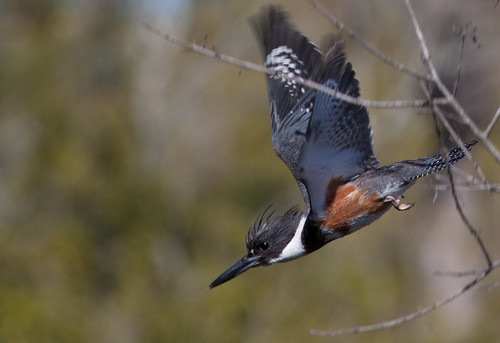 |
| Female Belted Kingfisher |
This funky looking bird—crested and blue like a jay, but with a way oversized head and bill and way undersized legs and feet, giving it an odd, top-heavy look—was one of the standouts when I was first thumbing through field guides. I must have been near kingfishers a lot in the spring of 1975, when I was out virtually every day, in appropriate habitat on the Michigan State University campus, as a brand new birder, and so I must have heard them many times before I recognized their unique rattle call. But I didn’t see my first one until I took a field ornithology class at the Kellogg Biological Station that summer. On June 30, we took a field trip to St. Timothy’s Church in Kalamazoo, Michigan, a little marsh-edged lake abutting the parking lot where our professor pointed out a gorgeous perched Belted Kingfisher—he also pointed out its rattle call several times. When I got home, I pulled out my bird record (this was in 1975, before CDs, and few bird recordings were available on cassette tape) and listened, over and over, to that thrilling call.
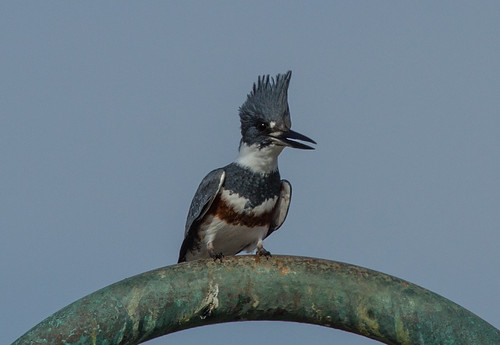 |
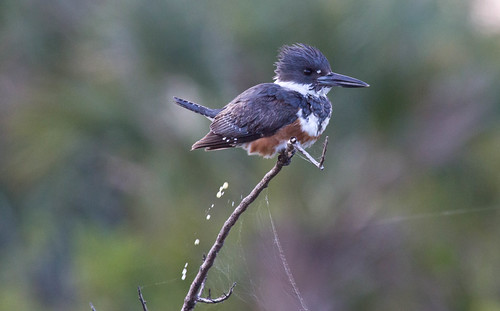 |
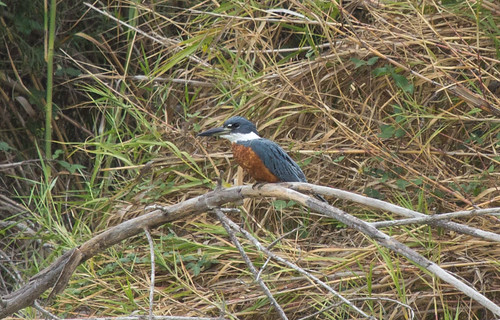 |
| Male Ringed Kingfisher |
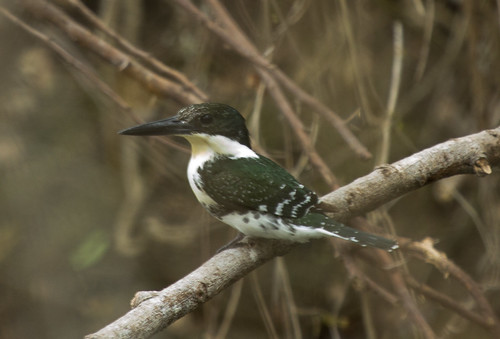 |
| Female Green Kingfisher |
It is derived from the Greek (h)alkyon also meaning “kingfisher.” Halkyon gives rise to the phrase “halcyon days” which, in the myth, are calm days at sea, so that the floating nest of the kingfisher [out in open water on the ocean, where people once believed they nested] will not be disturbed during the brooding period. The days were kept calm by order of the gods to honor the young of Halcyone, daughter of Aeolus, God of the Wind, who, when widowed, threw herself into the sea and was transformed into a kingfisher.Ancient Greeks had never seen a Belted Kingfisher—they were looking at the Common Kingfisher of Europe. Current taxonomists argue about how closely the American kingfishers are related to the European species, and some place our kingfishers in a different family, but the current American Ornithologists’ Union checklist keeps the world’s kingfishers in the same family, putting our North and South American ones in a different subfamily than the ones on other continents. The one bird in the world I most yearn to see, the Cuban Tody, is related to kingfishers, belonging to the same order (Coraciiformes), but in a different family (Todidae).
 |
| Cuban Tody painted by Jeannie Perry |
The Kingfisher's flight is remarkable for its beauty. How easily those long wings carry him about, as he skims so close over the water that their tips are sometimes wetted, or, as he hovers, his body appearing absolutely motionless, in that wonderful way which few birds can equal, for indefinite periods of time. Sometimes, especially in water half a foot or less in depth, he dives while flying nearly parallel to its surface. Sometimes, in his journeys from perch to perch when fish are plentiful, he dips again and again into the water in this way, reminding one of the Swallow as he gracefully touches the water here and there in his flight over the mill pond. Again, he drops like a falling stone in a nearly perpendicular line upon his fishy prey.Kingfishers are as secretive and protective about their best fishing holes as human anglers. Accounts I've read, in Bent and many other sources, emphasize the dramatic chases that kingfishers engage in when defending a territory, and I’ve seen that a lot myself over the years. But I never happened to be in the right place at the right time to see a triumphant kingfisher return to his perch after one of these chases until Russ and I were on Jekyll Island in Georgia a couple of weeks ago.
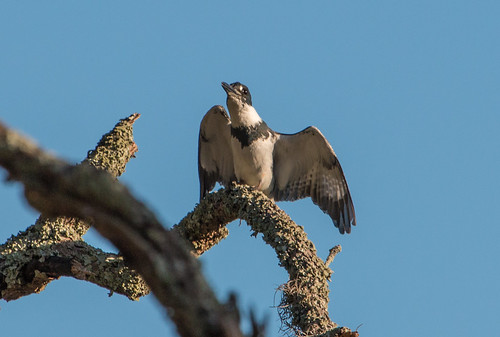 |
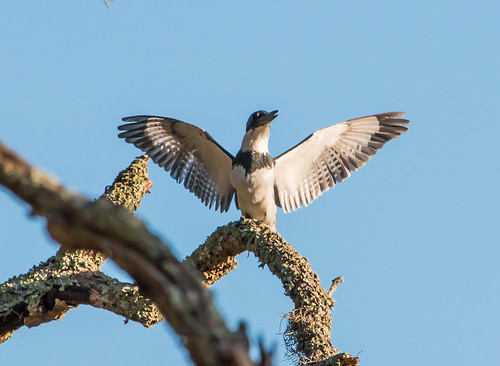 |
Adult kingfishers often regurgitate pellets, so when a scientist locates a spot where a kingfisher sits to digest, it is both legal and fairly easy to work out the bird’s diet. (Researchers used to regularly shoot birds and slice them open to examine their stomach contents.) Thanks to the many studies on them, we know that kingfishers eat a lot of prey besides fish, including frogs, small crabs and crayfish, mice, baby quail and ducklings, and even some berries.
They often fish from a perch, and their tiny feet allow them to sit on rather small twigs and wires when those give the best view of the water. They can also fly low over the water watching for food, or hover in place for many seconds watching the water below. After catching prey in their bill, they carry it to a perch and pound it over and over. This stuns the victim, serves to break off any fishy spines or the pincers of various crustaceans, and helps the kingfisher figure out which end is the head—that’s the end that will go down the hatch first. Interestingly, baby kingfishers can digest the bones and scales of fish, but lose this ability around the time they are ready to leave the nest.
The vast majority of Belted Kingfishers nest in burrows excavated into shoreline banks, and also use ditches, road cuts, landfills, and sand or gravel pits. There even exist accounts of them nesting in holes in dead trees and stumps. A typical nest begins with a tunnel at least 30 inches long, and often longer. The tunnel usually slopes upward from the entrance, probably to reduce chances of the nest flooding. The nest chamber itself starts out not much wider than the tunnel, but the chicks enlarge it as they grow. The adults’ regurgitated pellets of fish bones and scales and other undigested items accumulate on the nest floor, providing a bit of insulation for the eggs and then chicks.
The weirdly tiny feet of kingfishers are unusual in another way, too—they’re syndactyl—that is, the outer toes are partially fused. This foot design makes it pretty much impossible for kingfishers to walk—they shuffle in and out of their nest burrow, hardly shift foot position at all while perched, and otherwise move about by flying—but many ornithologists suggest that the foot design is perfect when the birds are excavating these burrows into sand banks. They use their massive bill to break up the soil and their thickened feet to shovel the loosened soil out the entrance.
 |
| Photo courtesy of Bill Hilton, Jr. Copyright 2012. All rights reserved. |
Kingfisher burrows are long, and to gain access to the eggs or young, people usually must destroy the nest. But around 1900, William L. Bailey found a way to study a family of young kingfishers. After finding a kingfisher’s nesting burrow, he managed to dig a hole from the rear to photograph the young. When he was done, he filled his access hole. He returned three more times, at different stages of the chicks’ growth, each time managing this without disrupting the nesting. He noted that when the young were about two days old they:
... were not only found wrapped together in the nest, but the moment they were put on the ground, one at a time, though their eyes were still sealed, they immediately covered one another with their wings and wide bills, making such a tight ball that when one shifted a leg, the whole mass would move like a single bird.Bailey explained:
This is a most sensible method of keeping warm, since the mother bird's legs are so short that she could not stand over them, but as they are protected from the wind and weather they have no need of her. Their appearance is comical in the extreme, and all out of proportion. This clinging to one another is apparently kept up for at least ten days, for a week later, when nine days old, they were found in exactly a similar position.Although very few ornithologists have ever observed this first hand, accounts of the ones who did all emphasize this peculiar habit of the chicks, clumping together like that.
This time of year, kingfishers are all done with nesting and are focused on getting through the coming winter. They obviously can’t remain anywhere where they can’t obtain food, but some manage to survive extremely cold winters where they still have access to fish. Some are seen occasionally in mid-winter even in Wisconsin and Minnesota where running streams remain open, and they can survive frigid winters in places, such as Yellowstone, where hot springs keep shallow ponds open.
Researchers haven’t done a lot of work tracking individuals to know what the survival rate is for these lingering birds, nor whether, if one disappears in January or February following extreme weather, it moved on or died. We don’t even know if the birds that overwinter further north get the edge on migrants in claiming and defending a good territory come spring. Some of our Belted Kingfishers winter throughout Mexico and Central America, but a great many—probably the bulk of them—are found throughout the central and southern states all winter.
The Breeding Bird Survey shows that Belted Kingfisher numbers have very slowly declined since 1966.
 |
| Breeding Bird Survey trend for Belted Kingfisher |
I love getting to spend time with kingfishers in Texas and Florida in mid-winter when they are most abundant. Unfortunately, even then they’re camera shy—I’ve taken bazillions of photos of them at a distance, but have a miserable time getting close enough for really great photos, and unlike Bill Hilton, Jr., I'm not a bander, so have never held one in my hands. That’s okay. Every encounter with kingfishers is fun and exciting even at a distance, and even after paying attention to them for almost 40 years, I’m still noticing and photographing new things about them. I expect I’ll be looking forward to seeing my next kingfisher as long as I live.
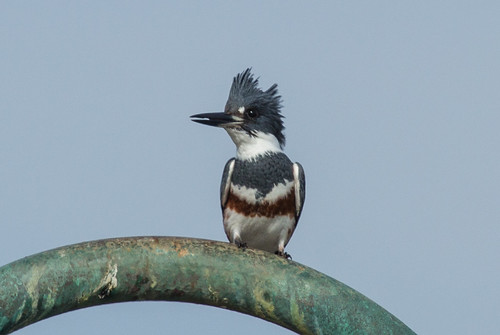 |